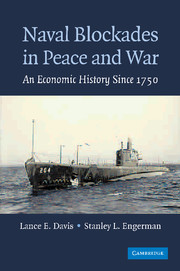Book contents
- Frontmatter
- Contents
- Preface
- 1 Introduction: “Thou Shalt Not Pass”
- 2 Britain, France, and Napoleon's Continental System, 1793–1815
- 3 The United States versus Great Britain, 1776–1815
- 4 The North Blockades the Confederacy, 1861–1865
- 5 International Law and Naval Blockades during World War I: Britain, Germany, and the United States: Traditional Strategies versus the Submarine
- 6 Legal and Economic Aspects of Naval Blockades: The United States, Great Britain, and Germany in World War II
- 7 The American Submarine and Aerial Mine Blockade of the Japanese Home Islands, 1941–1945
- 8 Blockades without War: From Pacific Blockades to Sanctions
- 9 Blockades, War, and International Law: What It All Means
- Conclusion
- Index
9 - Blockades, War, and International Law: What It All Means
Published online by Cambridge University Press: 18 August 2009
- Frontmatter
- Contents
- Preface
- 1 Introduction: “Thou Shalt Not Pass”
- 2 Britain, France, and Napoleon's Continental System, 1793–1815
- 3 The United States versus Great Britain, 1776–1815
- 4 The North Blockades the Confederacy, 1861–1865
- 5 International Law and Naval Blockades during World War I: Britain, Germany, and the United States: Traditional Strategies versus the Submarine
- 6 Legal and Economic Aspects of Naval Blockades: The United States, Great Britain, and Germany in World War II
- 7 The American Submarine and Aerial Mine Blockade of the Japanese Home Islands, 1941–1945
- 8 Blockades without War: From Pacific Blockades to Sanctions
- 9 Blockades, War, and International Law: What It All Means
- Conclusion
- Index
Summary
DEFINITIONS AND LAWS
Naval blockades can be traced back at least to the end of the sixteenth century, when vessel design had improved sufficiently to permit Dutch war ships to conduct a “blockade-like” operation against Spanish ports in Flanders. In 1630, in a major proclamation, the Dutch extended “to the investment by sea of coast towns the principles applicable to a siege in land warfare,” thus claiming a right to confiscate all neutral commerce. The proclamation stated that all ships sailing to or from those enemy ports would be confiscated. Not surprisingly, the concept of a legal blockade – a deployment of vessels whose missions were supposedly governed by a set of legal rules that covered the maritime activities of the warring parties as well as those of any neutral countries that became involved – was not immediately accepted by all governments. However, the terminology contained in various treaties among the Dutch, English, French, and Swedes between 1674 and 1679, as well as in the Treaty of Whitehall of 1689 make it clear that, even then, a “blockade” was widely understood to refer to the lawful exclusion of all commerce from an invested port or coastline.
Since that time, the debate over the legal rules governing blockades has been almost continuous; while, at the same time, serious questions about the possible effectiveness of such naval deployments have been raised.
- Type
- Chapter
- Information
- Naval Blockades in Peace and WarAn Economic History since 1750, pp. 417 - 426Publisher: Cambridge University PressPrint publication year: 2006



